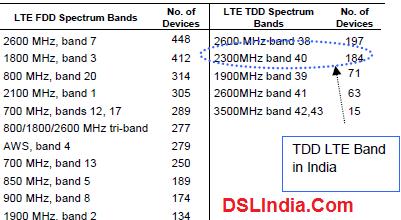 As we began the year 2014, 244 Wireless Operators have commercially launched LTE networks in 92 countries and 499 operators investing in LTE in 143 countries.
As we began the year 2014, 244 Wireless Operators have commercially launched LTE networks in 92 countries and 499 operators investing in LTE in 143 countries.
4G LTE can be deployed in two different combinations and the Relative Comparison of FDD LTE vs. TDD LTE is as shown below.
Deployment Frequency – TDD is offered primarily in the above – 2 GHz spectrum range whereas FDD is offered in the sub-2 GHz spectrum (700, 800, 900, 1800, 2100)
Paired Spectrum – TDD does not require paired spectrum as both transmission and reception occur on the same channel. FDD requires paired spectrum with sufficient frequency separation to allow simultaneous transmission and reception. TDD LTE ensures maximization of available bandwidth as the download to upload ratio are flexible.
Coverage TDD LTE has poor coverage compared to FDD and requires base station synchronization to avoid cross slot interference.
Hardware and User Equipment Costs Economies of scale in favor of FDD will lead to lower hardware and user equipment costs. However, the push from China Mobile and emerging interest from leading operators in Europe and US is expected to bridge this gap
Network Migration Most of the current 3G deployments are based on paired spectrum and as a result are easier to migrate to FDD LTE. However, TD LTE is expected to provide effective upgrade path for technologies such as TD-SCDMA, TD-HSPA and WiMAX
Devices for 4G LTE
Though network and device vendors as well as major mobile operators are committed to supporting both FDD and TD LTE technology, higher push is towards FDD. However multimode devices are available though costs can be a constraint. 1,240 LTE user devices are up and running across the Global 4G LTE Network. The following Chart Shows the 4G LTE Device Availability based on Spectrum Bands

Challenges in the LTE Eco-System
Transformation to LTE requires new radio access technology and core network expansion since existing 2G and 3G networks will not be phased out anytime soon, there is additional burden on operators to maintain two networks, support interoperability, seamless roaming, and handovers across multiple Communication Service Providers.
Operators need to upgrade their existing backhaul capacity as failure to do so could negatively
impact the end-user experience and the quality of service. Most operators including Airtelin India are rolling out their data-only LTE networks on limited devices such as USB modems due to the lack of a mature device ecosystem.